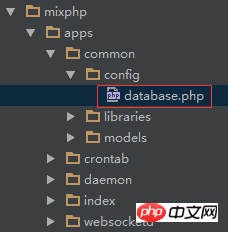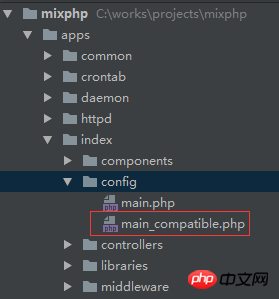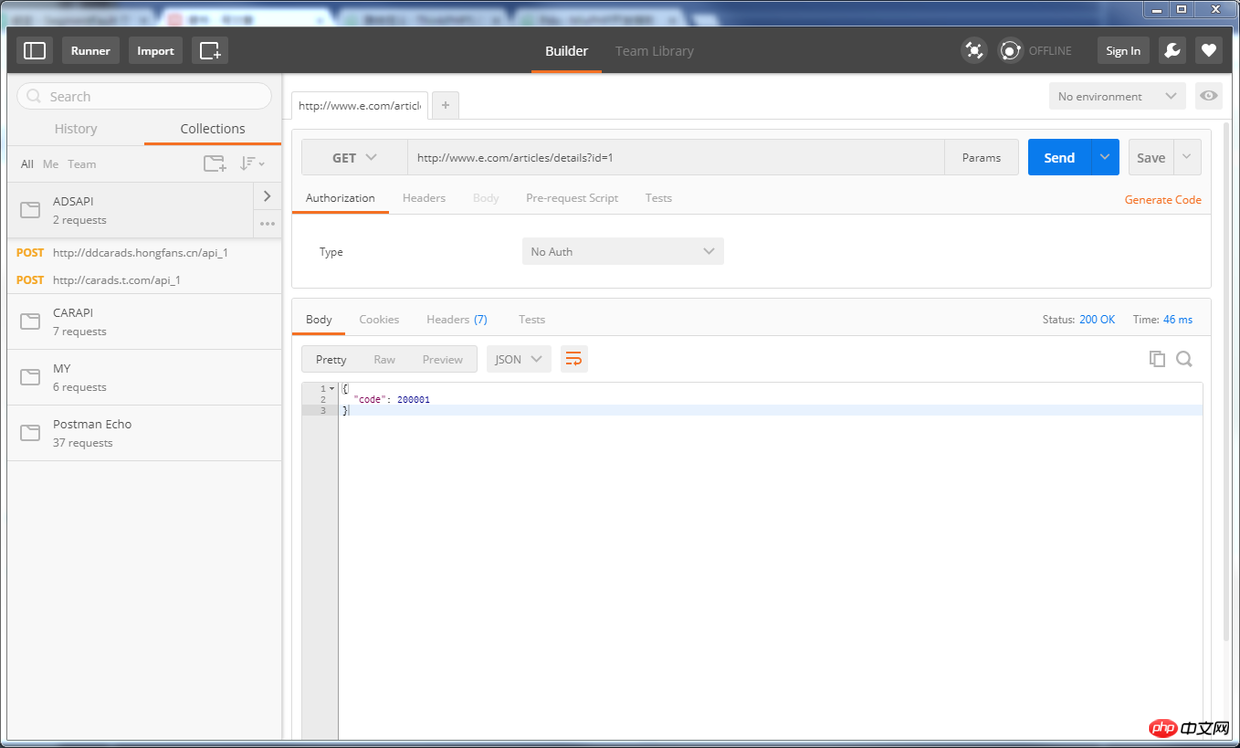How to use MixPHP to develop API interfaces
This article mainly introduces how to use MixPHP to develop API interfaces. It has certain reference value. Now I share it with you. Friends in need can refer to it
MixPHP is a common software based on Swoole. A memory-based PHP high-performance framework, the high-performance features of the framework are very suitable for developing API interfaces, and MixPHP is very close to the traditional MVC framework, so it is very simple to develop interfaces.
The following is a simple example of developing an API interface:
Get an article from the articles table through id.
URL to access this interface:
http://www.e.com/articles/details?id=1
The database table structure is as follows:
CREATE TABLE `articles` ( `id` int(10) unsigned NOT NULL AUTO_INCREMENT, `title` varchar(255) NOT NULL, `content` varchar(255) NOT NULL, `dateline` timestamp NOT NULL DEFAULT CURRENT_TIMESTAMP, PRIMARY KEY (`id`) ) ENGINE=InnoDB DEFAULT CHARSET=utf8;
Step 1
Modify the database configuration file, MixPHP In the application configuration file, information about the database refers to the common/config/database.php file.

Step 2
Modify the application configuration file:
Modify the default output format of the Response component to JSON format .
Modify the 404/500 error output format to JSON format.

The default 404/500 response of the framework is a web page, and the API service needs to respond to JSON data. Usually other traditional MVC frameworks need to modify many places. To meet this requirement, MixPHP itself provides this configuration, and you only need to modify the configuration.
MixPHP's default web application has two configuration files, namely:
main.php: used when deployed in mix-httpd.
main_compatible.php: Used when deployed in Apache/PHP-FPM.
When developing API, we recommend developing it under Apache/PHP-FPM, and then deploying it to mix-httpd after going online. Anyway, it will be seamless switching.
Now we modify the defaultFormat key under the response key name to mix\http\Error::FORMAT_JSON, as follows:
// 响应
'response' => [
// 类路径
'class' => 'mix\http\compatible\Response',
// 默认输出格式
'defaultFormat' => mix\http\Response::FORMAT_JSON,
// json
'json' => [
// 类路径
'class' => 'mix\http\Json',
],
// jsonp
'jsonp' => [
// 类路径
'class' => 'mix\http\Jsonp',
// callback键名
'name' => 'callback',
],
// xml
'xml' => [
// 类路径
'class' => 'mix\http\Xml',
],
],Then modify the format key under the error key name in the main_compatible.php file to mix\http\Error::FORMAT_JSON, as follows:
// 错误
'error' => [
// 类路径
'class' => 'mix\http\Error',
// 输出格式
'format' => mix\http\Error::FORMAT_JSON,
],Step 3
Create controller:
apps/index/controllers/ArticlesController.php
<?php
namespace apps\index\controllers;
use mix\facades\Request;
use mix\http\Controller;
use apps\index\messages\ErrorCode;
use apps\index\models\ArticlesForm;
class ArticlesController extends Controller
{
public function actionDetails()
{
// 使用模型
$model = new ArticlesForm();
$model->attributes = Request::get();
$model->setScenario('actionDetails');
if (!$model->validate()) {
return ['code' => ErrorCode::INVALID_PARAM];
}
// 获取数据
$data = $model->getDetails();
if (!$data) {
return ['code' => ErrorCode::ERROR_ID_UNFOUND];
}
// 响应
return ['code' => ErrorCode::SUCCESS, 'data' => $data];
}
}Create error code class:
apps/index/messages/ErrorCode.php
<?php
namespace apps\index\messages;
class ErrorCode
{
const SUCCESS = 0;
const INVALID_PARAM = 100001;
const ERROR_ID_UNFOUND = 200001;
}Create a form validation model:
apps/index/models/ArticlesForm.php
<?php
namespace apps\index\models;
use mix\validators\Validator;
use apps\common\models\ArticlesModel;
class ArticlesForm extends Validator
{
public $id;
// 规则
public function rules()
{
return [
'id' => ['integer', 'unsigned' => true, 'maxLength' => 10],
];
}
// 场景
public function scenarios()
{
return [
'actionDetails' => ['required' => ['id']],
];
}
// 获取详情
public function getDetails()
{
return (new ArticlesModel())->getRowById($this->id);
}
}Create a data table model:
apps/common/models/ArticlesModel.php
<?php
namespace apps\common\models;
use mix\facades\RDB;
class ArticlesModel
{
const TABLE = 'articles';
// 获取一行数据通过id
public function getRowById($id)
{
$sql = "SELECT * FROM `" . self::TABLE . "` WHERE id = :id";
$row = RDB::createCommand($sql)->bindParams([
'id' => $id,
])->queryOne();
return $row;
}
}The above is the writing of all the code.
Step 4
Use Postman to test, as follows:

The interface development and testing is completed, isn’t it very simple?
The above is the entire content of this article. I hope it will be helpful to everyone's study. For more related content, please pay attention to the PHP Chinese website!
Related recommendations:
Swoole's Learning - Analysis of Asynchronous Tasks
Swoole's Learning - Introduction to Swoole
The above is the detailed content of How to use MixPHP to develop API interfaces. For more information, please follow other related articles on the PHP Chinese website!

Hot AI Tools

Undresser.AI Undress
AI-powered app for creating realistic nude photos

AI Clothes Remover
Online AI tool for removing clothes from photos.

Undress AI Tool
Undress images for free

Clothoff.io
AI clothes remover

Video Face Swap
Swap faces in any video effortlessly with our completely free AI face swap tool!

Hot Article

Hot Tools

Notepad++7.3.1
Easy-to-use and free code editor

SublimeText3 Chinese version
Chinese version, very easy to use

Zend Studio 13.0.1
Powerful PHP integrated development environment

Dreamweaver CS6
Visual web development tools

SublimeText3 Mac version
God-level code editing software (SublimeText3)

Hot Topics
 1664
1664
 14
14
 1423
1423
 52
52
 1317
1317
 25
25
 1268
1268
 29
29
 1246
1246
 24
24
 Laravel Introduction Example
Apr 18, 2025 pm 12:45 PM
Laravel Introduction Example
Apr 18, 2025 pm 12:45 PM
Laravel is a PHP framework for easy building of web applications. It provides a range of powerful features including: Installation: Install the Laravel CLI globally with Composer and create applications in the project directory. Routing: Define the relationship between the URL and the handler in routes/web.php. View: Create a view in resources/views to render the application's interface. Database Integration: Provides out-of-the-box integration with databases such as MySQL and uses migration to create and modify tables. Model and Controller: The model represents the database entity and the controller processes HTTP requests.
 The Continued Use of PHP: Reasons for Its Endurance
Apr 19, 2025 am 12:23 AM
The Continued Use of PHP: Reasons for Its Endurance
Apr 19, 2025 am 12:23 AM
What’s still popular is the ease of use, flexibility and a strong ecosystem. 1) Ease of use and simple syntax make it the first choice for beginners. 2) Closely integrated with web development, excellent interaction with HTTP requests and database. 3) The huge ecosystem provides a wealth of tools and libraries. 4) Active community and open source nature adapts them to new needs and technology trends.
 How to learn Laravel How to learn Laravel for free
Apr 18, 2025 pm 12:51 PM
How to learn Laravel How to learn Laravel for free
Apr 18, 2025 pm 12:51 PM
Want to learn the Laravel framework, but suffer from no resources or economic pressure? This article provides you with free learning of Laravel, teaching you how to use resources such as online platforms, documents and community forums to lay a solid foundation for your PHP development journey from getting started to master.
 Laravel user login function
Apr 18, 2025 pm 12:48 PM
Laravel user login function
Apr 18, 2025 pm 12:48 PM
Laravel provides a comprehensive Auth framework for implementing user login functions, including: Defining user models (Eloquent model), creating login forms (Blade template engine), writing login controllers (inheriting Auth\LoginController), verifying login requests (Auth::attempt) Redirecting after login is successful (redirect) considering security factors: hash passwords, anti-CSRF protection, rate limiting and security headers. In addition, the Auth framework also provides functions such as resetting passwords, registering and verifying emails. For details, please refer to the Laravel documentation: https://laravel.com/doc
 Laravel framework installation method
Apr 18, 2025 pm 12:54 PM
Laravel framework installation method
Apr 18, 2025 pm 12:54 PM
Article summary: This article provides detailed step-by-step instructions to guide readers on how to easily install the Laravel framework. Laravel is a powerful PHP framework that speeds up the development process of web applications. This tutorial covers the installation process from system requirements to configuring databases and setting up routing. By following these steps, readers can quickly and efficiently lay a solid foundation for their Laravel project.
 How to view the version number of laravel? How to view the version number of laravel
Apr 18, 2025 pm 01:00 PM
How to view the version number of laravel? How to view the version number of laravel
Apr 18, 2025 pm 01:00 PM
The Laravel framework has built-in methods to easily view its version number to meet the different needs of developers. This article will explore these methods, including using the Composer command line tool, accessing .env files, or obtaining version information through PHP code. These methods are essential for maintaining and managing versioning of Laravel applications.
 What versions of laravel are there? How to choose the version of laravel for beginners
Apr 18, 2025 pm 01:03 PM
What versions of laravel are there? How to choose the version of laravel for beginners
Apr 18, 2025 pm 01:03 PM
In the Laravel framework version selection guide for beginners, this article dives into the version differences of Laravel, designed to assist beginners in making informed choices among many versions. We will focus on the key features of each release, compare their pros and cons, and provide useful advice to help beginners choose the most suitable version of Laravel based on their skill level and project requirements. For beginners, choosing a suitable version of Laravel is crucial because it can significantly impact their learning curve and overall development experience.
 The difference between laravel and thinkphp
Apr 18, 2025 pm 01:09 PM
The difference between laravel and thinkphp
Apr 18, 2025 pm 01:09 PM
Laravel and ThinkPHP are both popular PHP frameworks and have their own advantages and disadvantages in development. This article will compare the two in depth, highlighting their architecture, features, and performance differences to help developers make informed choices based on their specific project needs.




